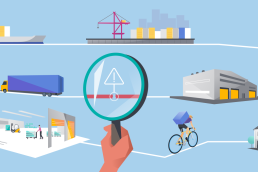Location-based services are fundamental to many modern digital solutions, from mapping tools to mobile apps that support last-mile delivery. In order to build functioning location-aware services, developers need access to the right application programming interfaces (APIs). Two of the most common choices are HERE Maps API and Google Maps API – but there are important differences between the two.
HERE Maps API vs Google Maps API
First of all, it’s a good idea to define exactly what Google Maps API and HERE Maps API actually do. These are platforms that enable developers to build location services, leveraging the data and features provided by either HERE or Google.
In terms of similarities, both platforms provide scalable APIs and SDKs that are comfortable handling large amounts of data traffic and leveraging powerful location-aware functionality. As well as the size of the datasets underpinning these platforms, both Google Maps and HERE Maps API are updated regularly, so developers can rest assured that any location-dependent solution they build will continue to reflect real-world development.
Developers should also note that both platforms make use of third-party resellers. For instance, at Local Eyes, we add value beyond that of a traditional reseller by offering our own unique support and expertise to ensure developers can get the most from the HERE Maps API platform.
Altogether, both platforms are able to leverage rich datasets and provide access to a range of navigation features. But in addition to their similarities, there are some differences to be aware of.

Firstly, in terms of price, Google Maps API operates on a pay-per-use model, while HERE developers will pay on a monthly basis. In other words, Google Maps API charges customers based on the number of requests they make. Developers will have access to up to $200 per month of credit, after which they will face additional charges. This $200 credit equates to 28,500 maploads per month.
As HERE Maps API works via a freemium model, no payment information is needed until customers exceed 250,000 transactions within a given month. Once this threshold has been crossed, developers can choose to sign up for the Data Hub or Pro plan, which will set them back $45 a month or $449 a month respectively. While this is a significant difference, high-volume businesses or those that require more advanced functionality are likely to require the Pro plan.
In terms of data storage, there are also significant differences between HERE Maps API and Google Maps API. HERE offers more flexibility, allowing certain types of content to be stored locally (for a fee) during the contractual period. Again, working with a licensed reseller is the safest way to ensure compliance when using data from either Google or HERE APIs.
Global industry analysis firm Counterpoint Research has once again named HERE Technologies as the leading location platform, maintaining its top position and surpassing TomTom, Google, Mapbox and more.
Named the “Switzerland of location platforms” because of its open, neutral and privacy-centric offering, HERE has earned the top spot this time due to its diverse portfolio across industries, applications and geographies.
Making the switch from Google to HERE
Deciding to move your app or web solution from Google Maps API to HERE Maps API is a major decision – but it might be the best one you ever make. Firstly, it’s important to realise that it’s not totally accurate to talk about either Google Maps or HERE as individual solutions. In reality, they are both suites of tools, encompassing geocoding, routing, mapping, SDKs and more. This may seem a little overwhelming at first but switching from one API to another is pretty straightforward. Here’s how to do it:
1. Do your research
Both Google and HERE have a great deal of history when it comes to developing location tools. Be sure to read about each party’s services and also the wealth of customer feedback available online. This should give you a good idea of which API is right for your needs.
2. Contact the right reseller
Getting in touch with a certified reseller should provide you with the answers you need regarding a particular API. At Local Eyes, for instance, we can help you navigate the various services built into the HERE Maps API, including the HERE Maps for JavaScript API, HERE REST architecture, and native Android and iOS SDKs.

3. Start with free access
The freemium model offered by HERE allows developers to get to grips with the API before they commit financially. Again, working with a reseller can help you find the right pricing plan and even access discounts should you decide to become a paying customer.
4. Maintain constant communication
Google Maps and HERE Maps APIs are subject to continuous updates, with new features being launched all the time. It’s important for businesses to remain aware of these updates if they are to use their chosen API to its full potential.
Explore all your options
Don’t simply stick with the Google Maps API because that’s what your developers have always used. It may be costing your team more than is necessary and may not offer the functionality your location-aware solutions need.
Get in touch with Local Eyes to find out how easy it is to switch to the HERE Maps API and the many benefits you could unlock.
Local Eyes B.V. is a leading reseller and integrator of geospatial technologies and data that has been contributing to its client’s success for the past 10 years by optimizing their decision-making and logistic processes. If you’re interested in learning more about how Local Eyes can provide Point-of-Interest data, get in touch today.



